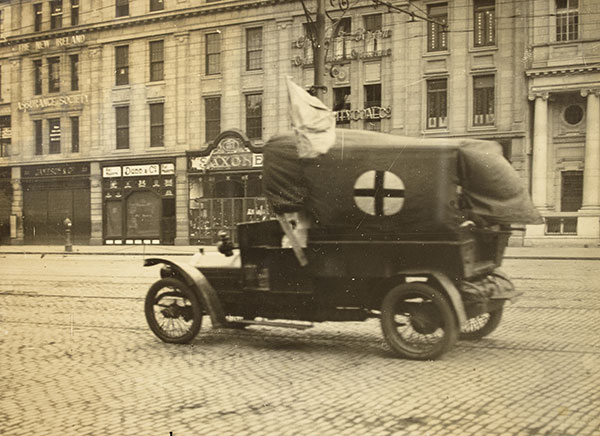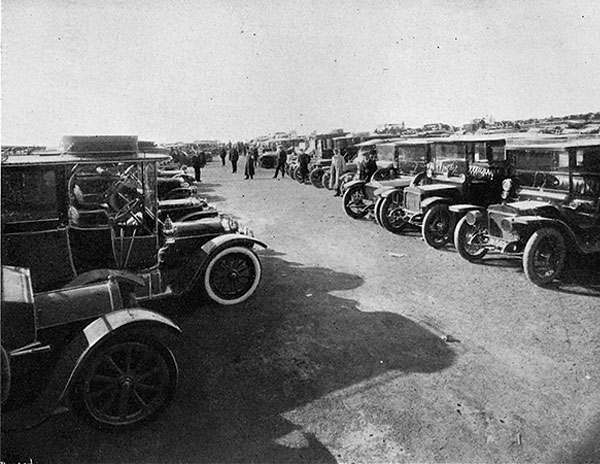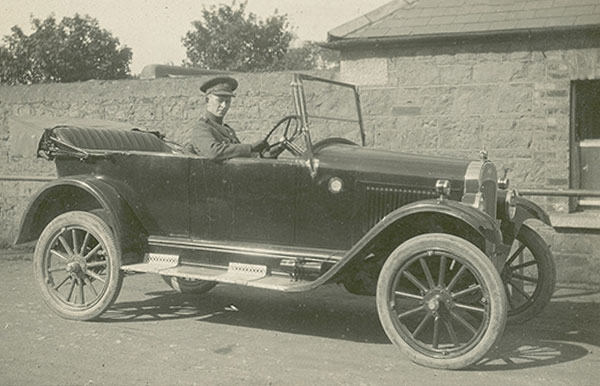‘Motors wanted!’
Published in Features, Issue 6 (November/December 2018), Revolutionary Period 1912-23, Volume 26Cars, canvassing and conveyance during the election.
By Leanne Blaney
‘Depressing and dull’ was how one English journalist described the conditions on polling day in London during the 1918 general election. In contrast, the Irish newspapers were full of reports of ‘exciting incidents’ that occurred across Ireland during the election campaign. These included the seizure of Joseph McLaughlin’s (Sinn Féin’s director of elections in North Donegal) motor bicycle by the RIC and an ‘election burglary’ in the Gweedore district, where a local garage was broken into and six cans of petrol were taken. According to the Derry Journal, the only trace that the burglars left behind for detectives was the instruction to ‘Vote for Sweeney’, daubed on the back of a motor car left on the premises.
Number of cars drastically reduced by 1918
In April 1914 the Irish Local Government Board estimated that 19,554 motorised vehicles were registered within Ireland; most of these were motor cycles and motor cars. Over the course of the First World War, however, owing to war restrictions on fuel and rubber, the number of cars actively in use fell drastically. Further restrictions were imposed in the aftermath of the 1916 Rising, during which cars were regularly employed by the Irish Volunteers, the Citizen Army and Cumann na mBan to transport members and officials. Therefore, even if Irish motorists had been able to keep their vehicles on the road, it was highly likely that their motoring activities were being closely observed by the local authorities—especially if they were suspected of having nationalist sympathies. The fact that every motor vehicle on the road also had to display its unique registration plate—which was registered to the driver as opposed to the specific car—meant that it was even more difficult for a motorist to maintain a degree of anonymity.

Above: Adapted cars, such as this Red Cross ambulance speeding down Sackville Street, had played a vital role during the 1916 Easter Rising. (NLI)
Still, nationalists remained convinced of the vital role that cars could play. This was especially true for canvassing and the conveyance of voters in rural districts, where some were required to travel over ten miles to polling stations. Consequently, during the four by-election successes of 1917 and the five by-elections that occurred in the first half of 1918, the availability of cars for use by the campaign team was considered essential. This is demonstrated by James McGuill’s recollection of the East Tyrone by-election, recorded in his Military Witness Statement (BMH No. 353). Having served as ‘director of transport’ during Sinn Féin’s successful contest of the South Armagh seat in February 1918, McGuill was sent to Dungannon a week before a by-election there, in order to ‘retrieve’ a ‘hopeless’ situation. On arrival, it was apparent that the transport situation was particularly dire. Desperate, McGuill pretended to buy the cars of local motorists who were willing to lend Sinn Féin their vehicles. By presenting each owner with a cheque for an amount equal to the value of the car, McGuill convinced the concerned owners that they would not be held responsible if the authorities stopped or seized their cars. As election day loomed closer and his supply of vehicles remained limited, McGuill contacted the local clergy and discovered that they were all due to attend a conference in Dungannon on polling day. The clergy (privately sympathetic to Sinn Féin’s cause) unanimously agreed that their cars—which conveniently would be parked outside the church—could be ‘borrowed’ by McGuill.
Having secured the vehicles, McGuill turned his attention to an adequate supply of petrol. With no time to appeal to Sinn Féin’s headquarters in Dublin for assistance, the local campaign team raided the petrol depot in Dungannon and acquired a small quantity of fuel. Salvation came in the form of the Ancient Order of Hibernians. The AOH had sent three cars from Dublin to work for the local Hibernian candidate, Thomas Harbenson, on the evening before polling. One of these drivers stopped and offered a local cattle-dealer a lift into Dungannon, provided that he gave them directions to the local Hibernian headquarters. Whether by accident or design, the cattle-dealer sent the drivers to the Sinn Féin headquarters, where McGuill promptly relieved them of their extra 30 gallons of petrol. Only when a messenger from the Hibernian headquarters arrived to inform the drivers of their mistake was the trick discovered.
Fuel
Such electoral experience proved invaluable to Sinn Féin when preparations for the 1918 general election began in September. Many of the other political parties resorted to placing advertisements in the national and local press, under the headline ‘MOTORS WANTED’, requesting volunteers ‘willing to lend a car or carriage’ to give their names in to the local campaign team’s headquarters. In contrast, the young men in charge of Sinn Féin’s campaigns now possessed both the contacts and the knowledge to secure adequate transport for the duration of the election. For instance, the limited petrol supply that had caused James McGuill such bother was now rectified, as Michael Joseph Ryan (BMH No. 633), one of the chief organisers of Sinn Féin’s campaign in South Longford, testified. Ryan recalled how a scarcity of petrol in the midlands meant that he travelled to Dublin in order to secure 80 gallons of petrol, which was stored in 40 fuel tins concealed under a pile of sawdust in a Dublin saw mill. Apparently this was not a unique solution and Michael Collins had been instrumental in the collection of the fuel. Harry Boland, meanwhile, was also involved in arranging for numerous drums of petrol to be lifted from a place of safekeeping and stored at Laurence Nugent’s premises at 22 Upper Baggot Street. Motorists from across Ireland travelled to Nugent’s yard to collect these supplies. Many within the motor industry happily offered assistance to Sinn Féin, regardless of the potential risks to their livelihoods. Mechanic Patrick Deloughry, a key figure within Kilkenny’s Sinn Féin campaign, provided party officials with large quantities of fuel even though he had no permit to do so and risked imprisonment if discovered by the authorities.

Above: Privately owned motor cars, such as depicted here in Motor News c. 1920s, were frequently commandeered for political purposes. (RIAC)
James McGuill and his brother had already been imprisoned during the winter of 1917 when they had put number plates bearing their own personal registration number ‘IY 10’ on all the vehicles volunteered for Sinn Féin’s cause in County Louth. The brothers took responsibility when some of the vehicles were stopped or spotted by the authorities, despite neither driving nor travelling in the vehicles. When Éamon de Valera and Austin Stack learned of this, they felt that it was an unfair sacrifice on the part of the two brothers and arranged that cars working for Sinn Féin displayed the registration plate ‘IR 1916’ for the rest of the by-elections. Furthermore, all drivers working for Sinn Féin during the general election were issued with driver’s licences, which read in English and Irish:
‘Irish Republic—The bearer is hereby authorized to drive and use the motor car in the performance of the duties assigned to him in the name of the Irish Republic—(signed) Éamon De Valera.’
Sanctions
Those employed within the motor industry were considered a valuable asset by Sinn Féin, as they could legitimately apply for and secure petrol permits and were sanctioned to drive vehicles further than the number of miles allowed by the local authorities. Such restrictions were imposed by the Motor Spirit (Consolidation) and Gas Restriction Order 1918, issued by Dublin Castle and the Irish Petrol Control Committee in January 1918. Amongst other clauses, the order specified that ‘a journey performed by … any person for canvassing purposes would not be a journey for the purpose of the “profession, trade or business” of such [a] person … It follows that [a] journey by volunteers or unpaid agents would [also] be a breach of the Order’ and that ‘A motor journey by a voter for the purpose of voting would be a breach of the Order’. Punishment for breaching the order varied from heavy fines to seizure of the vehicle and imprisonment of the owner/driver.

Above: National Army Brigadier General Niall MacNeill seated in his car. Cars continued to be of vital importance during both the War of Independence and the Civil War. (UCD Archives)
Though tightly enforced by certain RIC constabulary, these restrictions were regularly flouted during the elections. Given that many of Sinn Féin’s nominated candidates were still in prison, canvassing was largely carried out by orators and organisers such as Harry Boland and Fr Michael O’Flanagan. Fr O’Flanagan had previously played a prominent role in supporting Sinn Féin candidates, including Count Plunkett and Arthur Griffith, during their by-election campaigns. Having helped to prepare the Sinn Féin manifesto in 1918, he travelled widely to ratify various candidates. Remarkably, despite using a Ford car illegally, O’Flanagan was only stopped on one occasion, on the way to Enniskillen. An official summons was sent to Dublin, but the Dublin Metropolitan Police contacted the vehicle’s owner, Laurence Nugent (BMH No. 1769), and asked him to try and keep the priest out of the way so that the summons could not be delivered. Fortunately for all involved, this occurred during the final days of campaigning, and once polling began O’Flanagan went into a nursing home to convalesce.
Imprisonment did not prevent some Sinn Féin supporters from providing cars to help the cause. Joseph Lawless’s father was imprisoned in Usk Prison when he was nominated to stand as one of the Sinn Féin candidates in North County Dublin. Aware that he would be unable to play an active role in canvassing, he instructed his son to purchase a car to transport speakers to meetings, convey voters to polling stations and conduct any other relevant Sinn Féin activity (BMH No. 2043). Lawless managed to locate a 1914 Model T Ford and purchased it for a sum of £220. This was the car that famously transported Éamon de Valera back to Dublin city after his escape from Lincoln Prison in February 1919.
As with the by-elections held the previous year, the general election of 1918 provoked many demonstrations and protests. No party or politician was immune from the mobs that turned out to heckle canvassers. Consequently, many election directors identified the provision of cars as a priority, to ensure that their respective candidates made it through the election and emerged relatively unscathed. Candidates were typically driven to and from their speaking engagements, often accompanied by voluntary bodyguards—some of whom were armed. Safety was nonetheless not assured; in Kildare, John McCoy (BMH No. 492) noted how two of the cars used during Sinn Féin’s campaign had their windscreens broken. In Waterford, Nicholas Whittle (BMH No. 1105) recalled how the final car pulled up to the polling station at around 6.30pm with ‘the windscreen … smashed and the young driver, about twenty-two years of age, behind the wheel [sporting] a wide bandage around his head’.
Cars were also employed as tools to commit acts of violence during the election. Whittle admitted to a plot in his district to have a bully in the local IPP kidnapped from his home. A car sourced in Clare was to convey the prisoner to a rural part of that county, where he was to remain imprisoned until the election was over. Fortunately for the man, the plan was never implemented.
Ultimately, it could be argued that Sinn Féin’s success in 1918 owed more to their procurement of petrol than to their policies.
Leanne Blaney is an independent scholar whose interests include transport.
FURTHER READING
P. McMahon, British spies and Irish rebels: British Intelligence and Ireland, 1916–1945 (Woodbridge, 2008).
P. Murray, ‘O’Flanagan, Michael (1876–1942)’, Oxford Dictionary of National Biography.
















